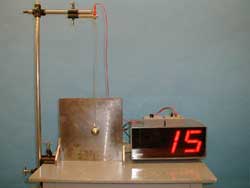Demos: 1N-01 Impact Time

An audio oscillator is connected to a metal ball by means of a wire from which the ball is suspended. A thick metal plate is placed in such a way that when the ball is pulled back and let go it will bounce against the plate. The plate is connected to a scaler so that when the ball and plate are in contact, a circuit is completed and the scaler records the time of contact. When contact is broken, the timer stops. Thus, we can measure the impact time, Dt. Variations of Dt with initial amplitude and different metals for the ball can be explored.
Directions: Turn on the oscillator and zero the scaler. Pull the ball back and release it. The time of impact will be of the order of milliseconds. Try a ball of another metal and try different amplitudes of swing.
Suggestions for Presentation: We often speak of “impulsive forces,” i.e. those that typically are of short duration and often can be quite large. Ask how we might be able to measure these very short intervals of time. Then explain briefly how the apparatus works.
An extension of this demonstration is a quantitative approximation of the impact force exerted by the ball and plate on each other. Pull the ball back to a known height, and from the conservation of mechanical energy, calculate the speed of the ball just before impact. Although it isn’t, approximate the collision as elastic and use the same number for the rebound speed. With the mass of the ball given, the impulsive force is
The quantity Dt is obtained in the impact time demo. In the case of the lead ball, the collision is decidedly inelastic and the calculated force will be too high. Nonetheless, the range of the force magnitude will be
Applications: The striking of baseballs with bats, golf balls with clubs, etc, are examples of very short impact times.
Last Updated: Nov 30, 2023 11:25 AM